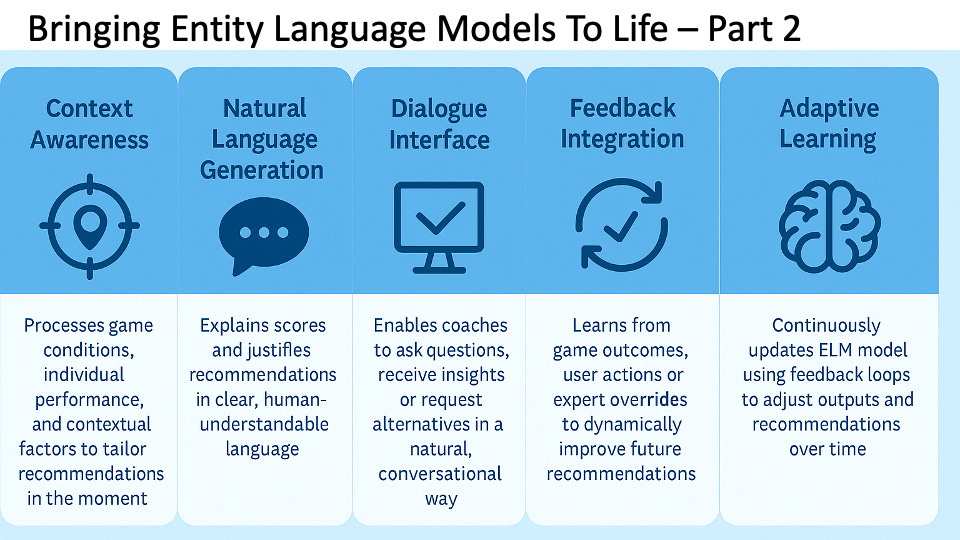Bringing Entity Language Models To Life… with Thinking Like a Data Scientist Methodology – Part 2
In “Bringing Entity Language Models to Life – Part 1,” we traced the journey of baseball icon Mike Trout—not just as a player, but as a data entity. We demonstrated how an Entity Propensity Model (EPM) could quantify his tendencies across game contexts and how that model could evolve into an Entity Language Model (ELM)—a generative AI-powered system capable of providing real-time, explainable decision support in the dugout or on the field.
Now, in Part 2, we will look behind the curtain to explore how Generative AI facilitates this transformation. We will showcase the capabilities that allow ELMs to adapt through usage, articulate themselves in human language, and continuously enhance their intelligence based on real-world outcomes. This is where predictive modeling intersects with operational learning—and where every decision becomes a training opportunity.
What Makes the Trout ELM So Powerful?
However, what genuinely distinguishes ELMs is their capacity to learn from each interaction—incorporating real-world feedback into their analytical core and continuously enhancing their effectiveness over time.
To fully appreciate what distinguishes an Entity Language Model from a traditional analytic profile, it is beneficial to break down the key features an ELM provides, especially when applied to a high-value “economic” asset like Mike Trout (Table 1).
Table 1: GenAI Key Capabilities
Why GenAI Makes ELMs Possible Now
While the most noticeable contribution of Generative AI in ELMs is its dialogue interface—translating analytic scores and actionable recommendations into clear, contextual guidance—this is just the beginning. GenAI also enhances the deeper intelligence and usability of ELMs in several critical ways:
Contextual Fusion merges structured and unstructured data, combining Statcast metrics with scouting notes or game commentary to create richer outputs.
Language Personalization adjusts explanations to suit different users (coach vs. analyst), increasing trust and clarity.
Scenario Simulation explores “what-if” matchups or hypothetical decisions, helping teams plan, not just react.
Just-in-time Explainability explains what is happening and why a recommendation is being made, complete with cited metrics.
Feedback Capture via Dialogue enables ELMs to learn from user behavior in natural conversation, which feeds directly into Step 8 of TLADS.
GenAI doesn't replace the math. It humanizes it. It makes AI conversational, coachable, and deployable at scale.
Thinking Like a Data Scientist + ELM = The New Playbook
The Entity Language Model (ELM) Feedback Loop serves as the engine that propels continuous intelligence. It captures predictive insights from Entity Propensity Models (EPMs) and transforms them into contextual, human-aligned guidance using explainable language. More than just a one-way recommendation engine, the ELM learns from every decision made, every override, and every outcome. This creates a virtuous cycle, where frontline actions feed back into the model, refining its logic, enhancing accuracy, and evolving it into an adaptive, increasingly intelligent decision support system. It’s where machine learning converges with human learning in real time.
By embedding ELMs into the Thinking Like a Data Scientist (TLADS) methodology, organizations can put real-time learning into practice. ELMs serve as both the delivery and sensing mechanisms, capturing user interactions, overrides, and outcomes directly at the point of decision. This feedback powers the ongoing refinement of both the analytic scores and features that support EPMs and the language, interfaces, and recommendations provided by the ELMs. The outcome? A self-improving system that becomes smarter, sharper, and more aligned with business needs each time it’s used.
This loop transforms static AI models into learning systems that adapt to context and user behavior over time (Figure X).
Figure 1: TLADS + Entity Language Model (ELM) Feedback Loop
Here is another perspective on the TLADS plus ELM integration, as interpreted by ChatGPT (Figure 2).
Figure 2: ChatGPT Version of the TLADS + ELM Feedback Loop
To better understand the impact that EPMs and ELMs have on the TLADS methodology, check out this table:
Table 2: EPM / ELM Impact on TLADS
Conclusion: Bringing ELMs to Life – Part 2
As we wrap up this two-part series on exploiting the power of Entity Language Models, I will continue to look for ways to enhance the TLADS methodology by integrating concepts like behavioral economics, generative AI, language models, and agentic AI. However, the TLADS methodology won’t lose its primary purpose: to help organizations leverage advanced analytics (AI, GenAI, ML, Reinforcement Learning, Deep Learning) with their wealth of data to derive and drive new sources of customer (constituent), operational and societal value.
My students will be exploring this deeply in our Fall semester class.



